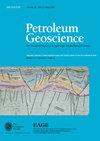通过地层正演模拟和敏感性分析研究不同生物生产对碳酸盐几何形状的作用:以Llucmajor为例
IF 2.1
4区 地球科学
Q3 GEOSCIENCES, MULTIDISCIPLINARY
引用次数: 2
摘要
碳酸盐岩台地的几何形状反映了多种因素的相互作用。然而,到目前为止,对产生碳酸盐的生物的影响的研究很少。本研究以中新世陆major台地为例,应用地层正演模拟(SFM)和敏感性分析,研究了寡光带和泛光带优势生物生产的变化对台地几何结构的影响。我们的研究结果表明,碳酸盐产量、水深和可容纳空间变化的复杂相互作用控制着平台的几何形状。退积的主要驱动力是低水位期间菱形藻沉积物的寡聚生产。该研究表明,台地的几何形状和内部结构根据主要产碳酸盐生物群的相互作用而发生显著变化。本研究的输入参数是基于对中新世碳酸盐岩生物群落的充分了解,这些生物群落具有生光、寡光和不依赖光的碳酸盐岩生产特征,其中至关重要的是,每个碳酸盐岩生产类别都是在模拟运行中明确建模的,而不是用单一碳酸盐岩生产深度剖面进行平均。这在基于地层正演模型的地下勘探研究中非常重要,在地层正演模型中,整个平台的几何形状可以通过校准运行来近似,但受地震调查和井眼的限制。然而,如果没有对目标碳酸盐岩系统的深入了解和向正演建模参数的转移,内部结构可能会过于简化。本文章由计算机程序翻译,如有差异,请以英文原文为准。
Investigating the role of differential biotic production on carbonate geometries through stratigraphic forward modelling and sensitivity analysis: the Llucmajor example
The geometry of carbonate platforms reflects the interaction of several factors. However, the impact of carbonate-producing organisms has been poorly investigated so far. This study applies stratigraphic forward modelling (SFM) and sensitivity analysis to examine, referenced to the Miocene Llucmajor Platform, the effect of changes of dominant biotic production in the oligophotic and euphotic zones on platform geometry. Our results show that the complex interplay of carbonate production rates, bathymetry and variations in accommodation space control the platform geometry. The main driver of progradation is the oligophotic production of rhodalgal sediments during the lowstands. This study demonstrates that platform geometry and internal architecture varies significantly according to the interaction of the predominant carbonate-producing biotas. The input parameters for this study are based on well-understood Miocene carbonate biotas with characteristic euphotic, oligophotic and photo-independent carbonate production in which it is crucial that each carbonate-producing class is modelled explicitly within the simulation run and not averaged with a single carbonate production–depth profile. This is important in subsurface exploration studies based on stratigraphic forward models where the overall platform geometry may be approximated through calibration runs, and constrained by seismic surveys and wellbores. However, the internal architecture is likely to be oversimplified without an in-depth understanding of the target carbonate system and a transfer to forward modelling parameters.
求助全文
通过发布文献求助,成功后即可免费获取论文全文。
去求助
来源期刊

Petroleum Geoscience
地学-地球科学综合
CiteScore
4.80
自引率
11.80%
发文量
28
审稿时长
>12 weeks
期刊介绍:
Petroleum Geoscience is the international journal of geoenergy and applied earth science, and is co-owned by the Geological Society of London and the European Association of Geoscientists and Engineers (EAGE).
Petroleum Geoscience transcends disciplinary boundaries and publishes a balanced mix of articles covering exploration, exploitation, appraisal, development and enhancement of sub-surface hydrocarbon resources and carbon repositories. The integration of disciplines in an applied context, whether for fluid production, carbon storage or related geoenergy applications, is a particular strength of the journal. Articles on enhancing exploration efficiency, lowering technological and environmental risk, and improving hydrocarbon recovery communicate the latest developments in sub-surface geoscience to a wide readership.
Petroleum Geoscience provides a multidisciplinary forum for those engaged in the science and technology of the rock-related sub-surface disciplines. The journal reaches some 8000 individual subscribers, and a further 1100 institutional subscriptions provide global access to readers including geologists, geophysicists, petroleum and reservoir engineers, petrophysicists and geochemists in both academia and industry. The journal aims to share knowledge of reservoir geoscience and to reflect the international nature of its development.
 求助内容:
求助内容: 应助结果提醒方式:
应助结果提醒方式:


